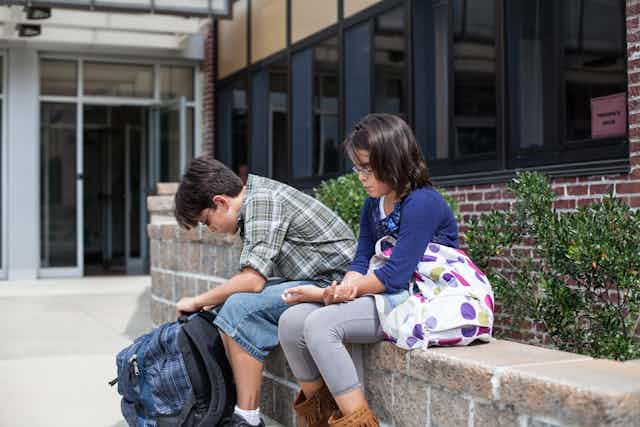Dubbed “A New Foundation for American Greatness,” President Donald Trump’s budget proposal for 2018 seeks to achieve faster economic growth and debt reduction. But only US$59 billion of that budget has been slated for education – a $9.2 billion cut (13.5 percent) compared to last year.
The education plan also eliminates or reduces more than 30 programs that Education Secretary Betsy DeVos and her team deemed to be duplicative of other programs, ineffective, or more fittingly supported with state, local, or private funds.
As experts in public finance and school-community partnership, we have seen the impact of many of these programs. Cuts to these programs and other aspects of the Trump-DeVos education plan could have long-lasting implications for America’s children – especially those living in poverty.

Eliminations and consequences
On the surface, the administration’s motivation for cutting these programs seems quite clear: Reducing expenditure on some existing programs or eliminating them altogether can give a measure of budget relief in the short-term. However, in our view the long-term consequences could be severe.
Consider, for example, the 21st Century Community Learning Centers program (CCLC), which provides afterschool academic enrichment for students in high-poverty communities. CCLC serves 2 million children at 11,500 centers nationwide. Performance audits conducted by the Department of Education in 2015 showed that “this broad reaching program touches students’ lives in ways that will have far reaching impact.”
At these centers, children in high poverty communities get additional help to benefit their math and English abilities, enhance class participation skills, and improve classroom behavior. According to the audit, nearly 50 percent of the children who participated reported improvements in their school grades and over 20 percent reported improvements in state assessment scores. Over 50 percent of teachers reported an improvement in homework completion and student behavior.
Under the Trump-DeVos plan, CCLC funding would be eliminated immediately. Research has shown that a more gradual phasing out of programs like CCLC gives schools and governments adequate time to determine whether the gaps left behind can be filled. In 2013, a similarly abrupt cut was made to Head Start, a preschool program that serves low-income families. The sudden eliminations left many families without daytime care for their 3- to 5-year-old children.
The new budget also plans to eliminate CCAMPIS, a program which subsidizes childcare for parents enrolled in college, and IAL, which provides high-quality books to school libraries. Both programs predominantly serve low-income families and both show a positive impact.

Who has a choice in school choice?
Some of these education cuts will be reallocated toward expanding charter schools, extending vouchers for private and religious schools, and supporting public schools to adopt choice-friendly policies. These reallocations, like the cuts, stand to impact low-income families the most.
Why? That comes down to who really has a choice when it comes to school choice.
While Secretary DeVos might claim that her proposed policy provides all families with the choice to select charter or private schools supported by vouchers, we know that children from low-income families, which now represent 51 percent of students in U.S. public schools, do not have the same access to choice as do children from middle- and upper-class families.
Whereas public schools are mandated to serve all children, charter and private schools serve children whose families learn about them, seek them out, and apply to them. But many parents face significant challenges in connecting their children with “choice” educational opportunities: The parents themselves may not be educated, may be illiterate, may not speak fluent English, may be without access to computers and/or phones, may be without sufficient transportation, or may be working more than one job. These challenges disproportionately affect families living in poverty.
As a result, DeVos’ focus on choice and vouchers is likely to widen – rather than reduce – the gap between children from low- and middle-income families.
There are ways to mitigate this (and some charter schools are doing so), but the DeVos proposal neither requires nor rewards these provisions. For example, the Children’s Aid Society’s College Prep Charter School has admissions criteria that advantage children who are low-income, English language learners, and/or “welfare-involved.”
While some charter schools across the country prioritize low-income students, the new budget gives schools no incentives to do so.

Educational inequity and the future
The United States spends more money than any other country on the education of children. We believe that this investment has yielded some substantial results in the educational achievement of American students: According to the National Center for Education Statistics, reading and math scores for fourth graders in the U.S. improved significantly between 2006 and 2011.
However, the role of federal funding in education is about more than increasing the overall academic performance of America’s children. Federal funding supplements the sometimes inequitable state and local government funding, ensuring that all students have an equal chance to succeed.
But in the case of the new budget, programs that bridge the gap for struggling low-income students are being eliminated in order to support school choice initiatives that are typically utilized by more affluent families.
In our conversations with parents of all income levels, we uniformly hear that what they most want for their children is for them to succeed beyond where they have. The DeVos budget proposal stacks the deck against parents currently struggling to make ends meet, making it even harder for them to see this hope realized for their children.

